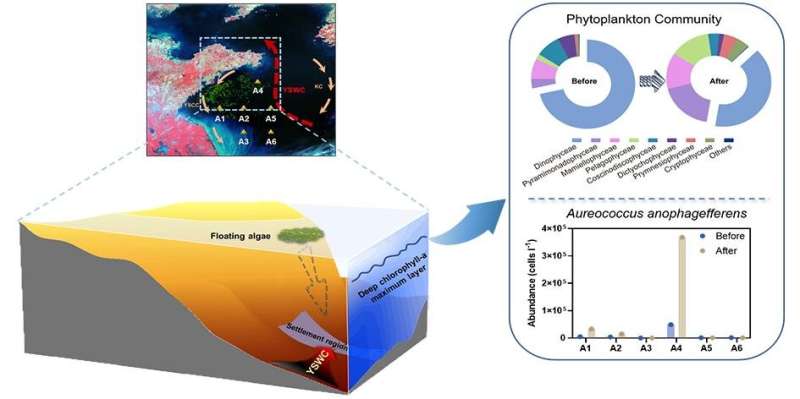Ecological consequences caused by green tides in Yellow Sea

Harmful algal blooms formed by fast-growing, ephemeral macroalgae have expanded worldwide. Green tides formed by Ulva prolifera in the Yellow Sea of China have become a notable marine ecological problem.
However, our understanding on the potential ecological consequences of macroalgal blooms is quite limited.
A research team led by Prof. Yu Rencheng from the Institute of Oceanology of the Chinese Academy of Sciences (IOCAS) has identified the settlement region of massive floating green algae and revealed the unique alteration of marine ecological environment in the settlement region under the influence of decline of green tides.
The study was published in Environmental Science & Technology on Feb. 8.
Using 28-isofucosterol in the surface sediment as a biomarker of green algae in genus Ulva, the researchers identified the settlement region of massive floating green algae in the area southeast of the Shandong Peninsula in the Yellow Sea.
"Changes in the phytoplankton assemblage in the settlement region could
be partially explained by the formation of the Yellow Sea Warm Current, and the increased relative abundance of pelagophyte was most likely driven by the settlement and decomposition of massive floating green algae," said Prof. Yu.The researchers investigated the responses of the phytoplankton assemblage from the deep chlorophyll-a maximum layer using high-throughput sequencing. Striking changes in the phytoplankton community in the settlement region were found after an intensive green tide in 2016, characterized by a remarkable increase in the abundance of the pelagophyte Aureococcus anophagefferens, which is the causative species of brown tides.
Brown tides of A. anophagefferens are typical ecosystem disruptive algal blooms. Their occurrence along coasts of the Bohai Sea and the Yellow Sea led to severe deleterious impacts on the scallop (Argopecten irradians) mariculture and economic animal seedling incubation industry.
The study suggests a linkage between green tides and brown tides in the Yellow Sea and Bohai Sea, and contributes to a more comprehensive understanding of the ecological consequences caused by green tides in the Yellow Sea.
More information: Jia-Yu Zhao et al, Green Tides in the Yellow Sea Promoted the Proliferation of Pelagophyte Aureococcus anophagefferens, Environmental Science & Technology (2022). DOI: 10.1021/acs.est.1c06502
Journal information: Environmental Science & Technology
Provided by Chinese Academy of Sciences



















